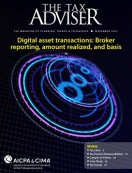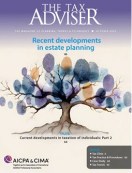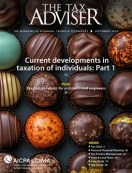- newsletter
- TAX INSIDER

Divorce post-TCJA: unexpected consequences
The repeal of the deduction for alimony payments is not the only change in law by the Tax Cuts and Jobs Act that will affect planning for a divorce.
Please note: This item is from our archives and was published in 2019. It is provided for historical reference. The content may be out of date and links may no longer function.
Related
Whether to choose a 529 or a Roth IRA to fund education expenses
Top seven mistakes when claiming Social Security benefits
Tax planning following the Tax Cuts and Jobs Act
By now practitioners are familiar with the direct change the law known as the Tax Cuts and Jobs Act (TCJA), P.L.115-97, made to divorce planning with the elimination of deductible alimony payments. A quick overview will be provided, and then ancillary and indirect changes that are not as obvious, but which might affect planning for divorced or divorcing clients, will be discussed. In many instances, the TCJA amendments will change long-time planning. These changes will require advisers to pause before giving advice so that they may ponder whether the fundamentals of planning still apply. In many cases they will not.
Most important, the ripple effects of the broad TCJA changes will have unexpected consequences that many clients will not even realize require seeking professional advice. CPAs should encourage all clients that are divorced, in the process of divorcing, or have prenuptial or post-nuptial agreements to meet with their adviser’s team to review the potential consequences.
TCJA direct changes
The primary direct divorce change of the TCJA is that alimony payments will not be deductible by the payer spouse but will also not be included in income of the payee ex-spouse. This change is permanent and will not sunset (as many other personal income tax changes do, unless Tax Reform 2.0 changes that). This new rule applies to any divorce or separation instrument (as defined in Sec. 71(b)(2)) executed after Dec. 31, 2018, or for any divorce or separation instrument executed on or before Dec. 31, 2018, and modified after that date, if the modification expressly provides that the TCJA amendments apply.
Planning tip: Practitioners determining the tax status of alimony payments should confirm the date of the divorce agreement, whether it was modified, and, if modified, whether the TCJA provisions apply. If there is any ambiguity as to whether a modification applied the TCJA rules, CPAs should request that the client’s matrimonial attorney confirm. For example, does a modification of a divorce agreement after 2018 “expressly” provide that the new rule should apply? Document the status of any agreement that the CPA is reporting for tax purposes in the client’s permanent tax file.
Planning consideration: Notify divorced clients paying or receiving alimony of the new rules.
Under pre-TCJA law, until the end of 2018, an alimony trust could have been used in a divorce to minimize the interactions of the former spouses. If a family business was involved, the alimony trust could have been used to hold interests in the business to protect the business interest while securing the interests of the payee spouse. The TCJA prevents the prospective use of alimony trusts in divorces after 2018 — with the TCJA’s repeal of Sec. 682, the spouse who creates the trust will be taxed on the income under the Sec. 672(e) grantor trust rules.
Indirect TCJA consequences practitioners should consider
The changes in the deductibility of alimony will have dramatic consequences to divorcing clients; that provision has received considerable attention. However, the TCJA made many other indirect changes that could have profound impact on divorcing clients. The discussion below points out only a few of these, but demonstrates how far-reaching the TCJA really is.
- Exemptions: Many divorce settlement agreements included good-faith negotiated provisions specifying which ex-spouse would get to claim which children as exemptions and in which years. The TCJA has suspended personal exemptions (other than for disability trusts that effectively will enjoy inflation-adjusted exemptions of $4,200 for 2019).The new larger standard deductions have been presented as a substitute for the lost personal exemptions. This elimination of personal exemption sunsets after Dec. 31, 2025. Clients who had given up other items of value to claim exemptions under the divorce settlement will be dismayed to learn that the bargained-for benefit has evaporated. There is likely little that can be done to salvage this. While it might be possible for the client to return to court to argue a change in circumstances, that will likely be more costly than the tax benefit lost.
- Fewer clients will plan their estates: A couple with a $6 million estate may view estate planning as irrelevant (assuming that they do not live in a decoupled state) as even a halving of the estate tax exemption will not result in their estates’ being taxable. The unfortunate consequence of this is that even many wealthy clients will rely on old simplistic wills that do not provide adequate trusts for divorce protection for their heirs. Outright bequests and bequests to simplistic trusts that distribute outright to a child at a specified age, e.g., 30, will expose all of those assets to divorce claims.
Planning consideration: Practitioners should endeavor to educate all clients that proper trust planning to protect against future divorce is critical regardless of whether the estate tax is relevant to their situation.
- Nongrantor trusts: Grantor trusts are the focus of much income and trust planning post-TCJA. However, clients making transfers to irrevocable trusts, unless they are very wealthy, will need access to trust assets. A trust can be structured to be both nongrantor and permit a spouse to have access by requiring that an adverse party, e.g., a remainder beneficiary whose interests will be reduced by the approved distribution, consent to any distribution to the spouse. Practitioners will have to consider the potential consequences of this if the couple later divorce. For example, who is named as the adverse party and what reaction will he or she have? Will he or she refuse to approve distributions post-divorce?
- State and local taxes: Might the loss of the full deduction for state and local taxes for a high-income spouse in a high-tax state have sufficient economic impact to create a financial hardship for a divorced client who faces a substantial tax increase? This might be particularly a concern for a professional in such a high-tax state who is subject to the limitation of being in a specified service trade or business and cannot avail himself or herself of the 20% Sec. 199A deduction. Might the SALT changes depress property values upsetting the intended implications of a negotiated settlement?
- Reliance on marital bequest: Many commentators are suggesting that a qualified terminable interest trust (QTIP) or other marital bequest is preferable to a credit shelter trust because assets receive a second basis step-up on the surviving spouse’s death. The reasoning for this is that the estate tax exemption is so high that there is no worry about aggregating all assets of the marriage in the survivor’s estate, i.e., there is no negative cost to a basis step-up. While there can be merit to this planning in some instances, its use could change the dynamic post-divorce. Many credit shelter trusts include the children of the marriage as beneficiaries whereas a QTIP cannot. If one spouse dies and the survivor remarries, there will be less or even no flexibility to get distributions to the children of that prior marriage if the assets are held in a QTIP. How might this affect future divorce planning?
- Changing prenuptial and divorce settlement agreements: Practitioners might consider suggesting that the client consult an attorney to reopen an existing divorce arrangement for changed circumstances. Might that succeed? If a prenuptial agreement already in place provides for a certain level of alimony (when it was anticipated it would be deductible under Sec. 215), would a court permit it to be modified now that, if the divorce occurs after 2018, it will no longer be deductible? To set aside a prenuptial or other marital agreement, the client might have to prove fraud, duress, overreaching, or unconscionability. Likewise, for reformation or rescission of a divorce agreement, including its property settlement terms, certain contract principles may apply, including mutual mistake and unjust enrichment. It remains to be seen whether the new issues that arise by virtue of the TCJA will constitute enough of a change in circumstances or other basis to warrant a modification in court.
The TCJA dramatically changed tax planning related to marriage and divorce in many ways — often indirect and unexpected — that could have varied and adverse impact on different clients.
Martin M. Shenkman, CPA/PFS, J.D., AEP, MBA, is an attorney at Shenkman Law in Fort Lee, N.J. For comments about this article or suggestions of topics for other articles, please contact Sally Schreiber, senior editor, at Sally.Schreiber@aicpa-cima.com.














